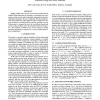Free Online Productivity Tools
i2Speak
i2Symbol
i2OCR
iTex2Img
iWeb2Print
iWeb2Shot
i2Type
iPdf2Split
iPdf2Merge
i2Bopomofo
i2Arabic
i2Style
i2Image
i2PDF
iLatex2Rtf
Sci2ools
97
Voted
ICIP
2003
IEEE
2003
IEEE
Context modeling and accessibility for 3D scalable compression
Highly scalable video compression based on invertible motion adaptive lifting transforms has emerged as a promising area in image processing research and an important component in interactive multimedia technology. However, within this feed-forward framework, the potential for coding efficiency improvement and its impact on random accessibility still has not been carefully assessed. In this paper, we compare the merits of several three-dimensional context coding strategies from an information-theoretic perspective. The variation in random access cost in response to coding parameter adjustments is analyzed, for a variety of spatial and temporal configurations.
Adaptive Lifting Transforms | Context Coding Strategies | ICIP 2003 | Image Processing | Random Access Cost | Random Accessibility | Scalable Video Compression |
Related Content
| Added | 24 Oct 2009 |
| Updated | 24 Oct 2009 |
| Type | Conference |
| Year | 2003 |
| Where | ICIP |
| Authors | Raymond Leung, David Taubman |
Comments (0)

